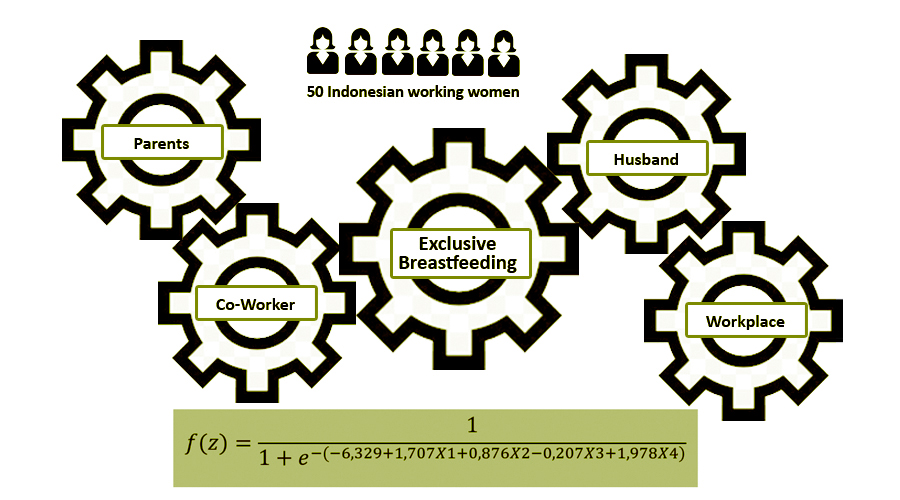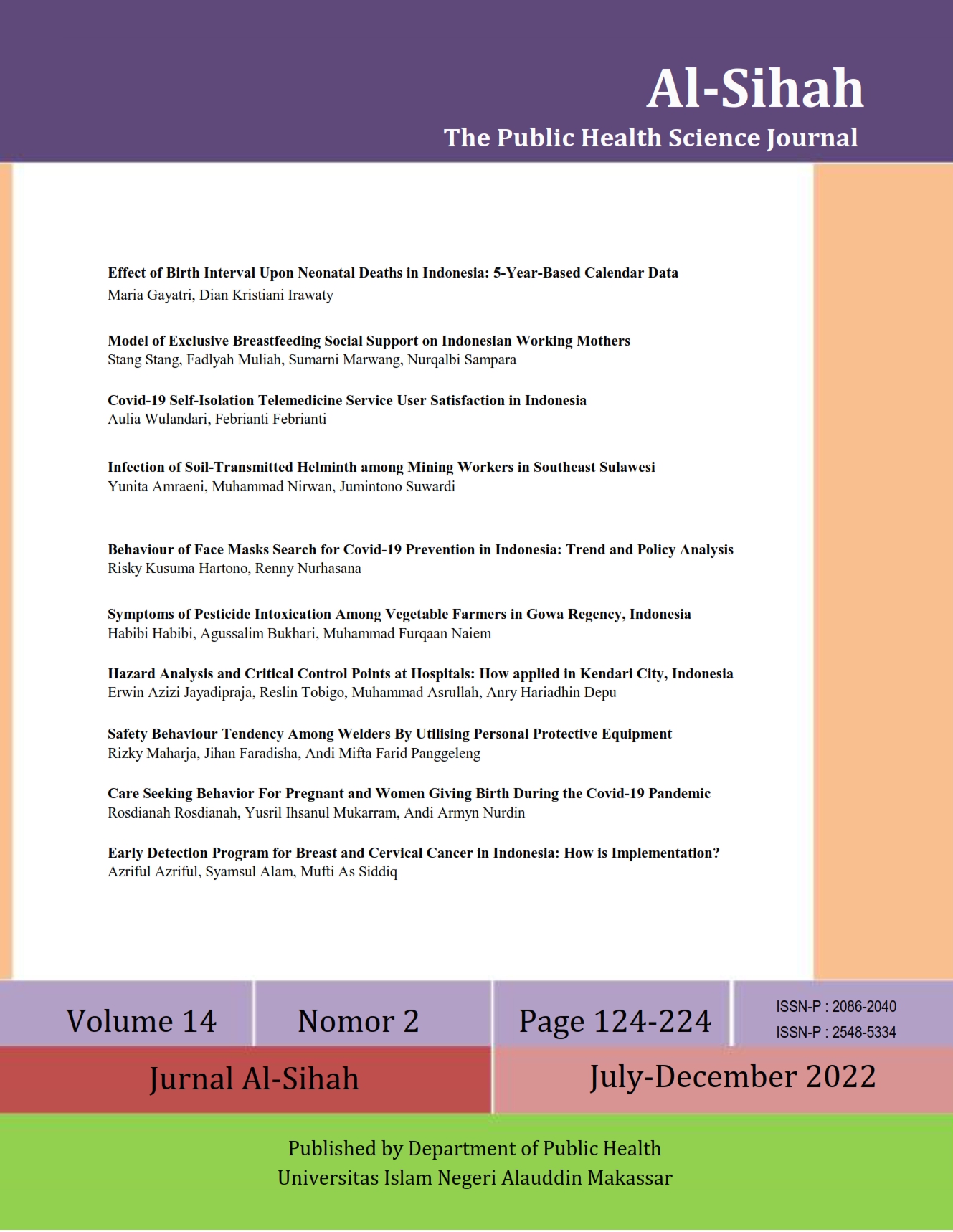Model of Exclusive Breastfeeding Social Support on Indonesian Working Mothers
Abstract
Working mothers' status is one of the factors that have influenced exclusive breastfeeding. The availability of social support for working mothers can affect whether exclusive breastfeeding is successful. This study's objective was to examine the different types of social support and design a social support model for working mothers in Indonesia. This study employed mixed methods and an explanatory sequential design. There were 400 working mothers with babies ranging in age from 6 to 24 months. The study included 25 working mothers who provided exclusive breastfeeding (cases) and 25 individuals who did not provide exclusive breastfeeding (control). The sampling method was purposive sampling. There were 11 informants, including working mothers who breastfed exclusively, health workers, and healthcare cadres. This study found a significant relationship between social support from the husband (p=0.002), co-workers (p=0.010), parents (p=0.047), and workplace (p=0.002) and exclusive breastfeeding for working mothers. Only the social support of the husband and the workplace determine the social support model in exclusive breastfeeding for working mothers. A husband's contribution is essential in providing social support through emotional and instrumental support.

Downloads
References
Abekah-Nkrumah, G., Antwi, M. Y., Nkrumah, J., & Gbagbo, F. Y. (2020). Examining working mothers’ experience of exclusive breastfeeding in Ghana. International breastfeeding journal, 15(1), 1-10. https://doi.org/10.1186/s13006-020-00300-0
Abie, B. M., & Goshu, Y. A. (2019). Early initiation of breastfeeding and colostrum feeding among mothers of children aged less than 24 months in Debre Tabor, northwest Ethiopia: a cross-sectional study. BMC research notes, 12(1), 1-6. https://doi.org/10.1186/s13104-019-4094-6
Alnasser, Y., Almasoud, N., Aljohni, D., Almisned, R., Alsuwaine, B., Alohali, R., Almutairi, O., & Alhezayen, R. (2018). Impact of attitude and knowledge on intention to breastfeed: Can mHealth based education influence decision to breastfeed exclusively?. Annals of medicine and surgery, 35, 6-12. https://doi.org/10.1016/j.amsu.2018.09.007
Andreas, N. J., Kampmann, B., & Le-Doare, K. M. (2015). Human breast milk: A review on its composition and bioactivity. Early human development, 91(11), 629-635. https://doi.org/10.1016/j.earlhumdev.2015.08.013
Ayalew, T. (2020). Exclusive breastfeeding practice and associated factors among first-time mothers in Bahir Dar city, North West Ethiopia: A community based cross sectional study. Heliyon, 6(9), e04732. https://doi.org/10.1016/j.heliyon.2020.e04732
Badran, E. F., Safadi, R., Al Qutob, R., Qutaishat, A. A., Masarweh, D. F., Bani-Hamad, Y. A., Khameesd, A. B., Shabsoughf, A. R., & Khamees, B. (2022). What support is needed prior to the designation as baby-friendly hospital?. Clinical Epidemiology and Global Health, 17, 101045. https://doi.org/10.1016/j.cegh.2022.101045
Chekol, D. A., Biks, G. A., Gelaw, Y. A., & Melsew, Y. A. (2017). Exclusive breastfeeding and mothers’ employment status in Gondar town, Northwest Ethiopia: a comparative cross-sectional study. International breastfeeding journal, 12(1), 1-9. https://doi.org/10.1186/s13006-017-0118-9
Dinas Kesehatan Provinsi Sulawesi Selatan. (2018). Profil Kesehatan 2018. https://dinkes.sulselprov.go.id/document/Profil%20Kesehatan
Dinas Kesehatan Provinsi Sulawesi Selatan. (2020). Profil Kesehatan 2019. https://dinkes.sulselprov.go.id/document/Profil%20Kesehatan
Francis, J., Mildon, A., Stewart, S., Underhill, B., Ismail, S., Ruggiero, E. Di, Tarasuk, V., Sellen, D. W., & Connor, D. L. O. (2021). Breastfeeding rates are high in a prenatal community support program targeting vulnerable women and offering enhanced postnatal lactation support: a prospective cohort study. International journal for equity in health, 20(1), 1-13. https://doi.org/10.1186/s12939-021-01386-6
Gebrekidan, K., Fooladi, E., Plummer, V., & Hall, H. (2020). Enablers and barriers of exclusive breastfeeding among employed women in low and lower middle-income countries. Sexual & Reproductive Healthcare, 25, 100514. https://doi.org/10.1016/j.srhc.2020.100514
Kavle, J. A., Picolo, M., Buccini, G., Barros, I., Dillaway, C. H., & Pérez-Escamilla, R. (2019). Strengthening counseling on barriers to exclusive breastfeeding through use of job aids in Nampula, Mozambique. PLoS One, 14(12), e0224939. https://doi.org/10.1371/journal.pone.0224939
Kementerian Kesehatan Republik Indonesia. (2019). Laporan Nasional Riskesdas 2018. Badan Penelitian dan Pengembangan Kesehatan. http://repository.bkpk.kemkes.go.id/3514/
Kim, J. H., Fiese, B. H., & Donovan, S. M. (2017). Breastfeeding is natural but not the cultural norm: A mixed-methods study of first-time breastfeeding, African American mothers participating in WIC. Journal of Nutrition Education and Behavior, 49(7), S151-S161. https://doi.org/10.1016/j.jneb.2017.04.003
Kozhimannil, K. B., Jou, J., Gjerdingen, D. K., & McGovern, P. M. (2016). Access to workplace accommodations to support breastfeeding after passage of the Affordable Care Act. Women's Health Issues, 26(1), 6-13. https://doi.org/10.1016/j.whi.2015.08.002
Kronborg, H., Harder, I., & Hall, E. O. (2015). First time mothers' experiences of breastfeeding their newborn. Sexual & Reproductive Healthcare, 6(2), 82-87. https://doi.org/10.1016/j.srhc.2014.08.004
Lau, Y., Pyai, T., Im, P., Su, S., Ho-lim, T., Chi, C., Tsai, C., Wen, K., & Klainin-yobas, P. (2017). Breastfeeding attitude, health-related quality of life and maternal obesity among multi-ethnic pregnant women: A multi-group structural equation approach. International Journal of Nursing Studies, 67, 71-82. https://doi.org/10.1016/j.ijnurstu.2016.12.004
Laugen, C. M., Islam, N., & Janssen, P. A. (2016). Social support and exclusive breast feeding among Canadian women. Paediatric and perinatal epidemiology, 30(5), 430-438. https://doi.org/10.1111/ppe.12303
Lestari, E. D., Hasanah, F., & Nugroho, N. A. (2018). Correlation between non-exclusive breastfeeding and low birth weight to stunting in children. Paediatrica Indonesiana, 58(3), 123-7. https://doi.org/10.14238/pi58.3.2018.123-7
Lok, K. Y. W., Bai, D. L., & Tarrant, M. (2017). Family members’ infant feeding preferences, maternal breastfeeding exposures and exclusive breastfeeding intentions. Midwifery, 53, 49-54. https://doi.org/10.1016/j.midw.2017.07.003
Lönnerdal, B. (2016). Bioactive proteins in human milk: health, nutrition, and implications for infant formulas. The Journal of pediatrics, 173, S4-S9. https://doi.org/10.1016/j.jpeds.2016.02.070
Mehta, R. V., Sreenivasa, M. A., Mathew, M., Girard, A. W., Taneja, S., Ranjan, S., Ramakrishnan, U., Martorell, R., Ryan, P. B., & Young, M. F. (2020). A mixed-methods study of pesticide exposures in Breastmilk and Community & Lactating Women’s perspectives from Haryana, India. BMC Public Health, 20(1), 1-14. https://doi.org/10.1186/s12889-020-09966-x
Nasrabadi, M., Vahedian-Shahroodi, M., Esmaily, H., Tehrani, H., & Gholian-Aval, M. (2019). Factors affecting Exclusive breastfeeding in the first six months of birth: An Exploratory-Descriptive Study. Journal of Midwifery and Reproductive Health, 7(3), 1749-1764. https://doi.org/10.22038/jmrh.2018.27330.1297
Ong, A. J., Kinshella, M. L. W., Salimu, S., Vidler, M., Elango, R., Banda, M., Dube, Q., Goldfarbe, D., Kawaza, K., & Nyondo-Mipando, A. L. (2022). Perceptions of expressed breast milk for preterm infants in Malawian hospitals: A qualitative study. Journal of Neonatal Nursing, 28(2), 113-117. https://doi.org/10.1016/j.jnn.2021.08.006
Oyay, A. F., Sartono, A., & Handarsari, E. (2020). Dukungan Ibu Kandung, Mertua dan Suami dengan Praktek Asi Eksklusif (0-6 Bulan) di Kampung Sereh Wilayah Puskesmas Sentani Papua. Jurnal Gizi, 9(1), 159-166. https://doi.org/10.26714/jg.9.1.2020.159-166
Quitadamo, P. A., Comegna, L., & Cristalli, P. (2021). Quitadamo, P. A., Comegna, L., & Cristalli, P. (2021). Anti-infective, anti-inflammatory, and immunomodulatory properties of breast milk factors for the protection of infants in the pandemic from COVID-19. Frontiers in Public Health, 8, 1–29. https://doi.org/10.3389/fpubh.2020.589736
Ratnasari, D., Paramashanti, B. A., Hadi, H., Yugistyowati, A., Astiti, D., & Nurhayati, E. (2017). Family support and exclusive breastfeeding among Yogyakarta mothers in employment. Asia Pacific journal of clinical nutrition, 26(Supplement). 31–35. https://doi.org/10.6133/apjcn.062017.s8
Riaz, S., & Condon, L. (2019). The experiences of breastfeeding mothers returning to work as hospital nurses in Pakistan: A qualitative study. Women and Birth, 32(2), e252-e258. https://doi.org/10.1016/j.wombi.2018.06.019
Shobo, O. G., Umar, N., Gana, A., Longtoe, P., Idogho, O., & Anyanti, J. (2020). Factors influencing the early initiation of breast feeding in public primary healthcare facilities in Northeast Nigeria: a mixed-method study. BMJ open, 10(4), e032835. https://doi.org/10.1136/bmjopen-2019-032835
Srisopa, P., & Lucas, R. (2021). Maternal perception of paternal breastfeeding support: A secondary qualitative analysis. Midwifery, 102, 103067. https://doi.org/10.1016/j.midw.2021.103067
Supriyanto, A. L. D., Kristianti, S., & Suwoyo, S. (2021). Hubungan Dukungan Keluarga Dengan Pola Pemberian ASI Pada Bayi Usia 0-6 Bulan. Jurnal Pendidikan Kesehatan, 10(1), 85-100. https://doi.org/10.31290/jpk.v10i1.2027
Syam, A., Iskandar, I., & Kadrianti, E. (2019). Breastfeeding Performance Among Potentially Depressed Nursing Mothers. Global Journal of Health Science, 11(13), 1-59. https://doi.org/10.5539/gjhs.v11n13p59
Thet, M. M., Khaing, E. E., Diamond-Smith, N., Sudhinaraset, M., Oo, S., & Aung, T. (2016). Barriers to exclusive breastfeeding in the Ayeyarwaddy Region in Myanmar: Qualitative findings from mothers, grandmothers, and husbands. Appetite, 96, 62-69. https://doi.org/10.1016/j.appet.2015.08.044
Ulfa, M., Tahir, A. M., Mallongi, A., & Rachmat, M. (2020). Effect of education media on improvement visual acetate acid inspection at Sudiang community health center. Enfermeria clinica, 30, 439-443. https://doi.org/10.1016/j.enfcli.2019.10.118
Wood, F. E., Gage, A. J., & Bidashimwa, D. (2020). Insights on exclusive breastfeeding norms in Kinshasa: findings from a qualitative study. BMC pregnancy and childbirth, 20(1), 1-14. https://doi.org/10.1186/s12884-020-03273-4
World Health Organization. (2019). Global Breastfeeding Scorecard. https://apps.who.int/iris/handle/10665/326049
Yanti, E. S. (2021). Dukungan Ayah ASI terhadap Keberhasilan ASI Eksklusif. Muhammadiyah Journal of Midwifery, 1(2), 67-74. https://doi.org/10.24853/myjm.1.2.67-74
Copyright (c) 2022 Stang Stang, Fadlyah Muliah, Sumarni Marwang, Nurqalbi Sampara

This work is licensed under a Creative Commons Attribution-NonCommercial-ShareAlike 4.0 International License.
Authors retain copyright and grant the journal right of first publication with the work simultaneously licensed under a Creative Commons Attribution-NonCommercial-ShareAlike 4.0 International License that allows others to share the work with an acknowledgment of the work's authorship and initial publication in this journal.
Authors are able to enter into separate, additional contractual arrangements for the non-exclusive distribution of the journal's published version of the work (e.g., post it to an institutional repository or publish it in a book), with an acknowledgment of its initial publication in this journal.
Authors are permitted to publish their work online in third parties as it can lead to wider dissemination of the work.






